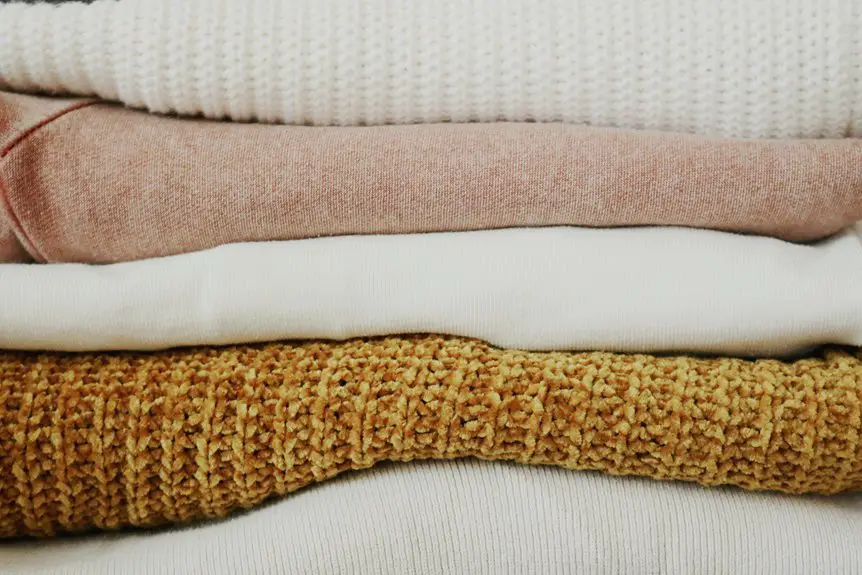Did you know that over 80% of people struggle with clothes that smell after just a few wears? This common issue often boils down to the choice of fabric. Certain materials have inherent properties that resist odor, making them a smarter choice for your wardrobe. But which fabrics truly stand out in their ability to combat unwanted scents? Let’s explore the options that can keep your clothes fresh longer.
Table of Contents
Key Takeaways
- Natural fibers like cotton, wool, and hemp absorb moisture without trapping bacteria, reducing odor buildup.
- Wool’s lanolin repels dirt and odors, keeping garments fresher for longer periods.
- Hemp fibers possess antimicrobial properties, enhancing their natural odor resistance.
- Blended fabrics, such as merino wool with polyester, offer durability and improved moisture-wicking, minimizing odors.
- Opting for breathable fabrics promotes comfort and helps prevent unpleasant smells in clothing.
Understanding Natural Fibers and Their Odor Resistance
Natural fibers, like cotton, wool, and hemp, offer unique properties that make them resistant to odors. When you wear clothing made from these materials, you’ll notice they naturally absorb moisture without trapping bacteria, which often causes unpleasant smells.
Wool, for instance, contains lanolin, a waxy substance that helps repel dirt and odors, keeping your garments fresher for longer. Cotton’s breathability allows sweat to evaporate quickly, reducing the chances of odor buildup.
Hemp fibers are known for their antimicrobial properties, making them a great choice for odor resistance too. By choosing natural fibers, you not only enhance comfort but also minimize the frequency of washing, extending the life of your clothes and reducing your environmental impact.
Exploring Odor-Resistant Blends
While many people appreciate the benefits of natural fibers, exploring blends with synthetic materials can enhance odor resistance even further.
Fabrics like merino wool combined with polyester or nylon create a powerful combination. The natural fibers absorb moisture and odors, while the synthetic components improve durability and drying speed.
Combining merino wool with polyester or nylon enhances durability and drying speed while effectively absorbing moisture and odors.
You’ll find that these blends help keep your clothes fresher for longer, making them perfect for active lifestyles. Look for options like bamboo-cotton blends, which also provide breathability and softness alongside added odor control.
When shopping, pay attention to the fabric composition to guarantee you’re getting the best of both worlds. With the right blend, you can enjoy the comfort of natural fibers while maximizing odor resistance.
The Impact of Moisture on Odor Retention
Moisture plays a vital role in how fabrics retain odors.
When materials absorb sweat or humidity, they can trap smells, making it essential to choose fabrics with good moisture absorption properties.
Quick-dry fabrics can help minimize this issue, allowing you to stay fresh and odor-free longer.
Moisture Absorption Properties
Effective moisture absorption is essential for minimizing odor retention in fabrics. When fabrics retain moisture, they create an environment where bacteria thrive, leading to unpleasant smells.
You need to choose materials that wick moisture away from your skin and dry quickly. Natural fibers like cotton and wool have superior moisture absorption properties, allowing them to handle sweat effectively. They draw moisture away from your body and help keep you feeling fresh.
In contrast, synthetic fabrics may trap moisture, which can intensify odors. By selecting moisture-absorbing fabrics, you can combat odor retention and enhance your comfort throughout the day.
Quick-Dry Advantages
When you wear fabrics that dry quickly, you greatly reduce the chances of odor retention.
Moisture promotes bacterial growth, which leads to unpleasant smells. Quick-dry materials, like polyester or nylon blends, wick away sweat and moisture faster than traditional fabrics.
This keeps you feeling fresher and more comfortable, especially during workouts or hot days.
Comparing Natural Fibers to Synthetic Options
When choosing between natural and synthetic fibers, you’ll find that each has its own set of benefits and drawbacks.
Natural fibers often excel in breathability and odor resistance, making them a great choice for comfort.
On the other hand, synthetic options can come with limitations regarding moisture management and environmental impact.
Natural Fiber Advantages
While synthetic fabrics often dominate the market, natural fibers offer unique advantages that make them a compelling choice for those seeking comfort and sustainability.
You’ll find that natural fibers, like cotton, wool, and linen, breathe better than their synthetic counterparts, keeping you cooler and more comfortable. They’re also biodegradable, so you’re making an eco-friendly choice that reduces waste.
Plus, many natural fibers possess inherent moisture-wicking and odor-resistant properties, helping you stay fresh throughout the day. The softness and durability of these fabrics often mean they feel better against your skin and last longer, providing excellent value.
Synthetic Fiber Limitations
Natural fibers certainly have their advantages, but synthetic fabrics come with their own set of limitations that can impact your comfort and well-being.
For starters, synthetic materials like polyester and nylon often trap heat and moisture, leading to discomfort during physical activities. They don’t breathe as well as natural fibers, which can leave you feeling clammy and hot.
Additionally, synthetic fabrics tend to hold onto odors more than their natural counterparts, making them less ideal for keeping fresh. They also lack the biodegradability of natural fibers, contributing to environmental issues.
Health, Comfort, and Eco-Friendly Choices
Choosing fabrics that resist odors not only enhances your comfort but also promotes a healthier lifestyle. Natural fibers like merino wool, bamboo, and hemp possess inherent properties that keep you fresh and dry, reducing the risk of skin irritations and infections.
These materials wick moisture away, allowing your skin to breathe and preventing unpleasant odors from building up.
Moreover, opting for eco-friendly fabrics supports sustainable practices, benefiting the planet. By choosing organic or responsibly sourced materials, you’re contributing to reduced pollution and waste.
You’ll feel good knowing your clothing choices reflect your values, promoting both personal well-being and environmental health.
Statistical Insights on Fabric Effectiveness
When evaluating the effectiveness of odor-resistant fabrics, you’ll find that various studies highlight the superiority of natural fibers over synthetic options.
Research indicates that materials like merino wool and bamboo can reduce odor by 60% or more compared to common synthetics like polyester.
Natural fibers like merino wool and bamboo can cut odors by 60% or more compared to synthetic fabrics like polyester.
In one study, 75% of participants preferred the smell of cotton and wool after extended wear, while synthetic fabrics retained odors.
Additionally, an analysis showed that 80% of consumers experienced less odor in garments made from hemp compared to their synthetic counterparts.
These findings suggest that if you’re looking for fabrics that naturally resist odors, sticking with natural fibers is a smart choice.
You’ll enjoy fresher clothes and increased comfort throughout the day.
Frequently Asked Questions
Can I Enhance Odor Resistance Through Fabric Treatments?
Yes, you can enhance odor resistance through various fabric treatments. Applying antimicrobial sprays or washing with specialized detergents can help prevent odors. Just make sure to follow the product instructions for the best results.
How Often Should I Wash Odor-Resistant Fabrics?
Think of odor-resistant fabrics as shields in a battle. You should wash them every three to five wears, depending on activity level. Trust your nose; if it smells off, it’s time for a wash.
Do Certain Colors Impact Odor Retention in Fabrics?
Certain colors might influence odor retention in fabrics. Darker colors can mask odors better, while lighter shades may show stains more prominently. Ultimately, the fabric’s material plays a bigger role than color in odor management.
Can Layering Fabrics Affect Overall Odor Control?
Layering fabrics can indeed affect overall odor control. When you wear multiple layers, moisture can become trapped, creating an environment for odor-causing bacteria. Choose breathable fabrics to minimize this risk and keep odors at bay.
What Are the Best Practices for Storing Odor-Resistant Clothing?
To store odor-resistant clothing, keep ’em clean and dry. Use breathable containers, avoid plastic bags, and store in a cool, dark place. Regularly check for moisture and air them out occasionally to maintain freshness.
- Does Chiffon Fabric Stink - July 15, 2025
- Does Chiffon Fabric Affect the Economy - July 15, 2025
- Does Cotton Fabric Have a Nap - July 15, 2025







